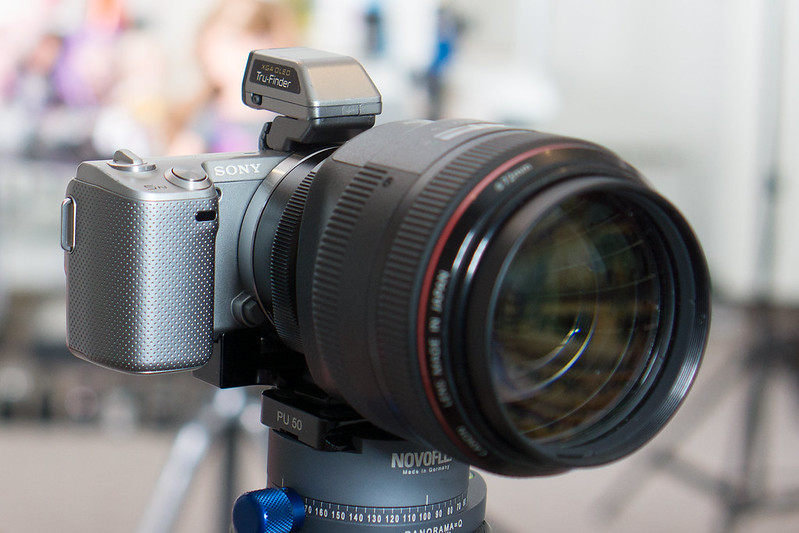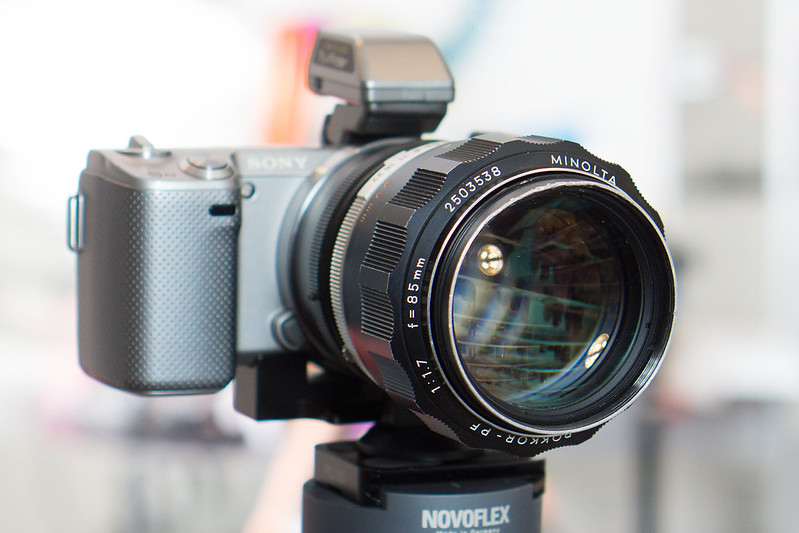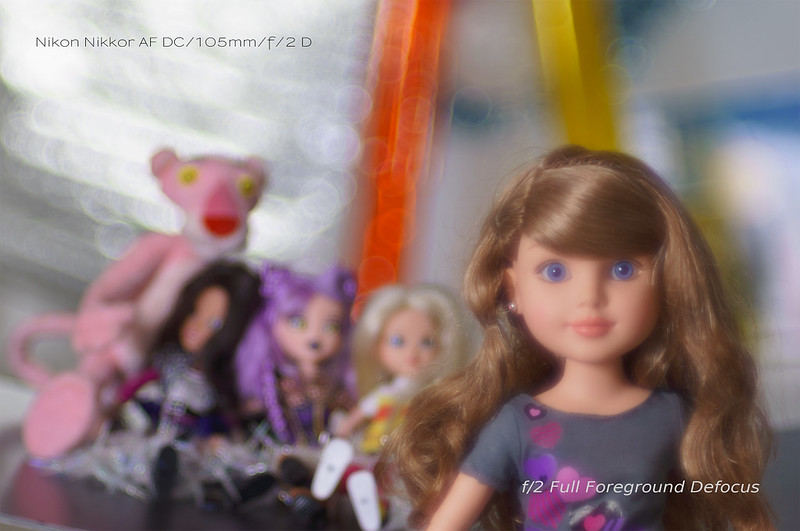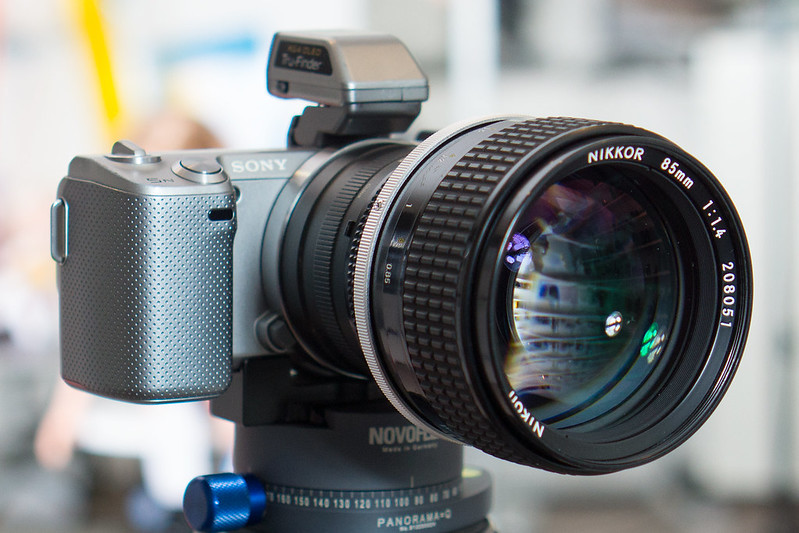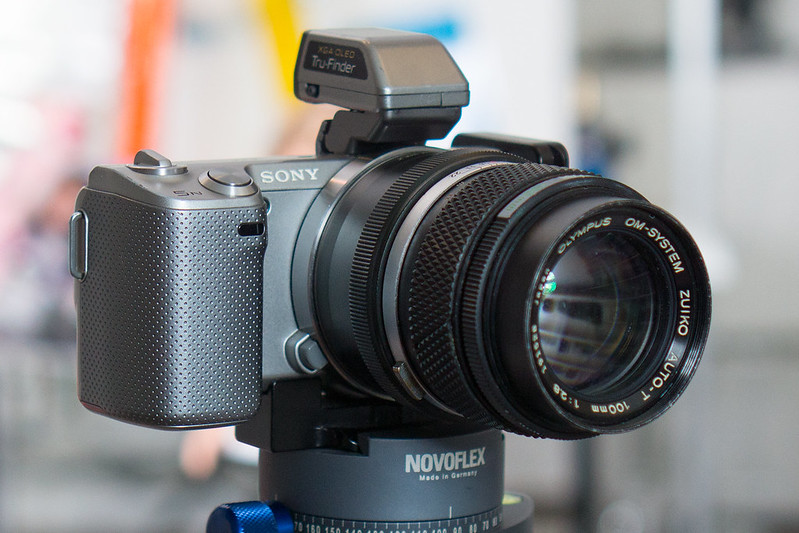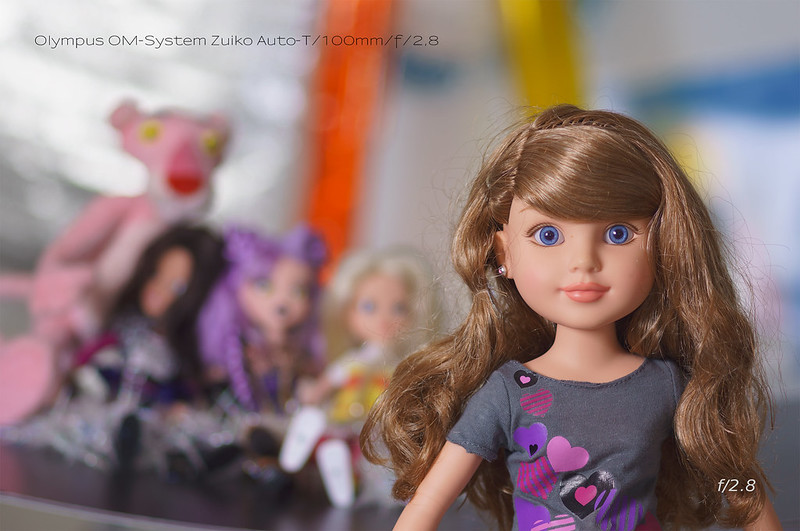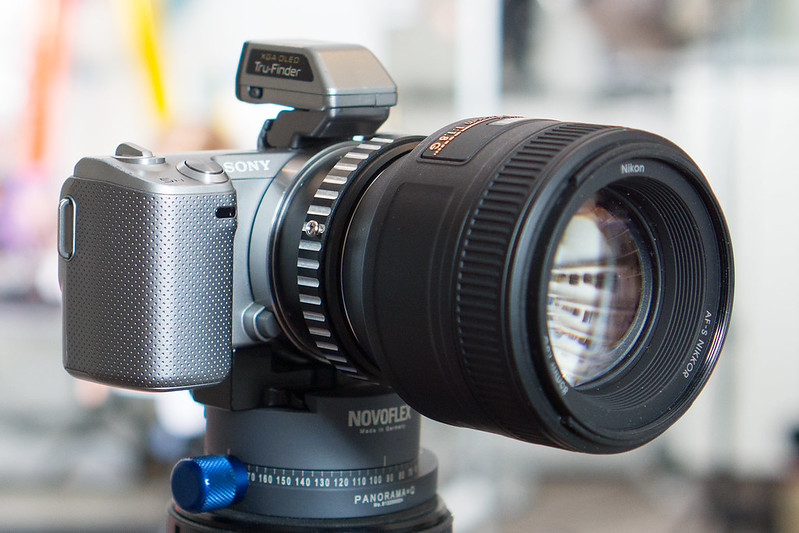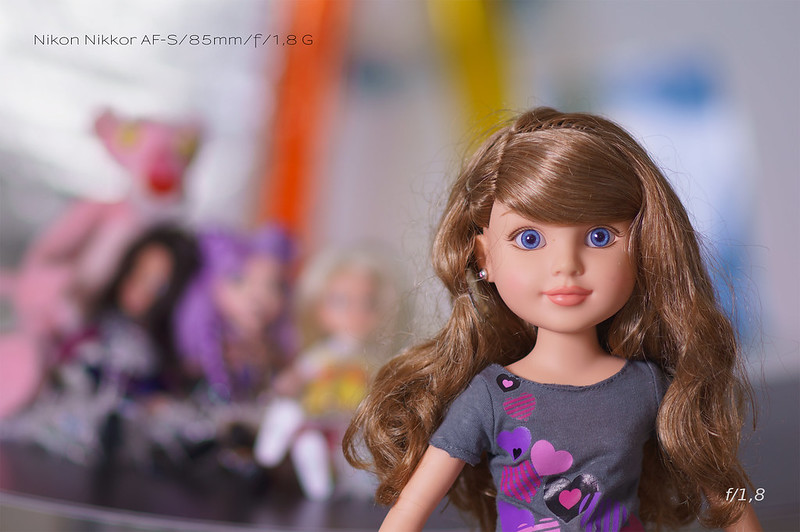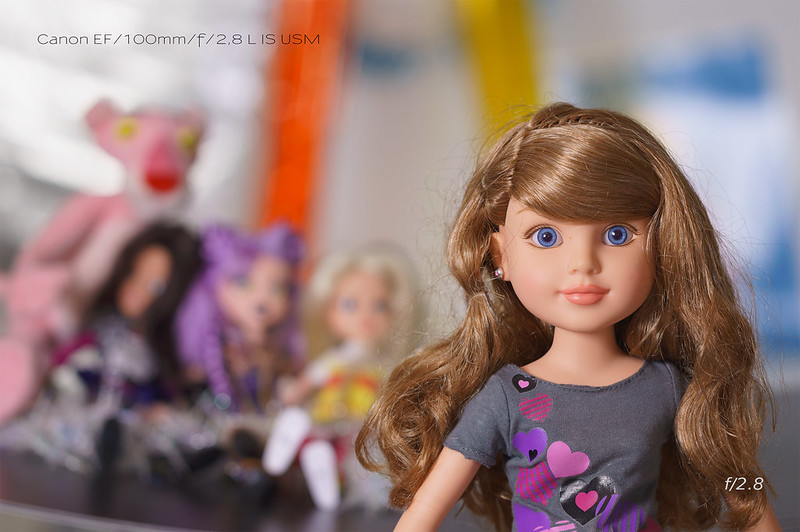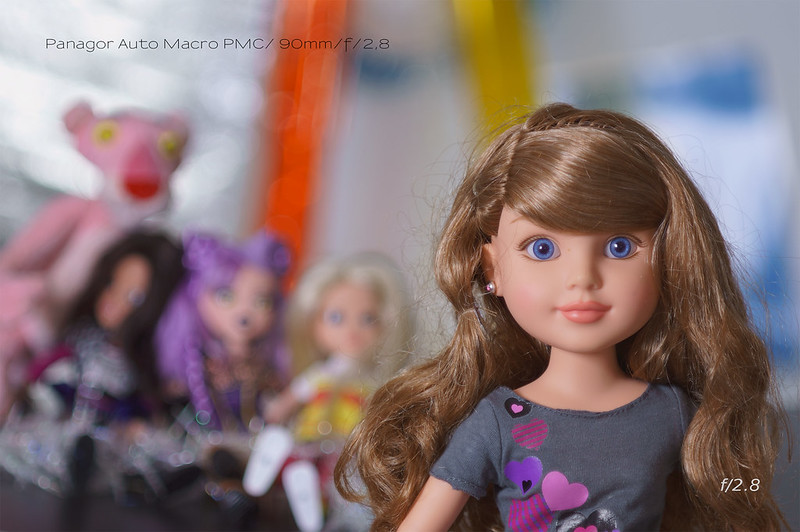Canon EF 85 f/1.2 L USM II is one of the best standard portrait lenses ever made by anyone.
Click here to see more images in the Flickr set
What’s good:
Combination of extremely smooth bokeh, enforced by a native shallow DOF of f/1.2 and punchy colors and contrast at the same aperture, generated Canon 85L fame as one of the best standard portrait lenses ever made by anyone. In terms of professional clean look (if you master light, styling etc. of course), you will hardly find better lens.
What’s not so good:
It is the most expensive lens in this comparison. AF is very slow even of native Canon bodies. It is big and heavy beast and both – front and rear glass elements are quite protruded and vulnerable. But for me, the worst part of its otherwise outstanding image quality is huge amount of purple fringing in the high contrast transitions. As I like to shot portraits in a direct back-light (and I don’t mind loss of contrast and light flares), this lens is not for me. But I will probably never sell it, for those rare occasion, when I want its unique look in studio.
Final word:
If you can afford it, buy it, because otherwise, you will always feel to miss the legend. Play with it a bit, get amazed, and then sell it to the next follower. I really doubt that you will use it very often if you are not professional.
22.
This Minolta lens is beautiful old fashioned design with improved coating in comparison to those even older Sonnars. Thanks to the coating, global contrast is higher and colors are punchier. At the same time, acutance is not very high though…
Click here to see more images in the Flickr set
What’s good:
Like it’s smaller brother – 58/1.2, this Rokkor feature great build quality and it is a real joy to use, despite its size and weight. In terms of optical quality it has very good global contrast and nice color rendition.
What’s not so good:
It isn’t really sharp lens wide open, which wouldn’t normally mind if bokeh will be outstanding, but it is not. It is neutral, nothing more to that. At f/1.7 I would expect better results when it comes to subject isolation. However, it might perform differently at different distances and lighting condition. Follow my blog, I will add more photos in the flickr sets, as they come.
Final word:
Great lens for Rokkor lovers. For the rest of us, Minolta 85/2 MD should be better option from what I have seen. But I can’t still find one in a good condition and for the reasonable price…
23.
Contarex is a Sonnar with the best build quality I ever held in my hands. Very good IQ, but no MC, so it will flare. That’s great :-)))
Click here to see more images in the Flickr set
What’s good:
It is as rare if not even more than Biotar 75/1.5. I believe that only about 22000 pieces were produced and not more than 6-7000 were black. It was supposed to be part of the most prestigious equipment line for Zeiss. It’s IQ is exclusive, maybe not that specific as already mentioned Biotar, but certainly better balanced.
What’s not so good:
It already sound expensive, and it really is. Considering that you can get its clone (Jupiter 9) or even its closer sibling Sonnar 85/2 for Contax I/Kiev mount, for much cheaper money, there is little extra in terms of IQ, that Contarex can offer. No multi-coating, so expect problems (or gifts, depending on your POV) in the back-light situations.
Final word:
Exclusive Sonnar 85, that probably cost more than it should, but that’s because it is rather collectors item. It delivers very good IQ with its own personality and it will make you feel special. There are however more exciting lenses in terms of IQ for less money in this focal range. (I am saying this mainly, because I want to remain the only one who is using it in the field today :-))
24.
I can only advise to search the web for more images taken with this lens. Unless you have a chance to try it on your own, that will give you best idea about its possibilities.
Click here to see more images in the Flickr set
What’s good:
It is no doubt unique lens in every respect. DC control feature (de-focus control), is very interesting tool to play with, but even bare (in neutral DC position) this lens has outstanding optical performance. I mentioned Takumar 85/1.8 lens to be one of the best balanced lenses in the field, but this Nikkor goes a step further. Sharper with higher contrast and smoother bokeh. It can’t get much better than this.
What’s not so good:
Due to its size and weight, this lens belongs to the DSLR. It is not an easy lens to handle on NEX, especially if you want to play with DC. That and its price tag, makes it less spectacular than its optics would suggest.
Final word:
Imagine LensBaby on steroids. If you don’t want to play with DC, you can still use it with amazing results in DC neutral position, as any other lens. But the option that will make your images looking completely different on your next photo portrait workshop, than those from other attenders, is a finger twist away. If you have long fingers and deep pockets of course… Highly recommended. (Oh wait, where did I heard that?)
25.
Nikkor 105/1.8 is a special lens. While it suffer from slightly larger CA wide open, it becomes much better at f/2.8 and above.
Click here to see more images in the Flickr set
What’s good:
It’s one of rare 105/1.8 lenses on the market, which means – one of the fastest in this focal length FF lenses. While it probably was a marketing decision to make it this fast, rather than optical engineers wish, it works well even wide open.
What’s not so good:
Chromatic aberrations and rather harsh bokeh for this shallow DOF are a bit disappointing.Then comes the size, weight and price.
Final word:
If it would be only Nikkor lens in this range, you shouldn’t look further. But there is cheaper, smaller, lighter, sharper and more distinctive 105/2,5 AI-S. On the other hand, f/1.8 gives you faster shutter speeds and more importantly shallower DOF. If you think it is negligible difference, you are right. But it is. If you don’t believe me, check it on Flickr (link above). By clicking between f/1.8 and f/2 in the view mode, you will see, that even that little, make quite a difference in an overall look.
26.
Nikkor 85/1.4 is a great portrait lens. Bokeh is very special wide open.
Click here to see more images in the Flickr set
What’s good:
While most people agree, that new G version of this lens is better in every respect, I would disagree in one single point. Bokeh is nicer with AI-S version. The way, this lens is mixing colors is something that is quite rare to see. There are few slightly better ones in that respect, but usually at longer focal lengths. (Minolta/Sony 135/2.8 (T4.5) STF i.e.)
On the other hand, highlights are not that smooth, but combination of both, creates unique rendering and that is what I am after in this tests.
What’s not so good:
Hard to say… It could be smaller, lighter, cheaper as usual and CA could be even better controlled. But overall, there is little to blame it for. Sharper? Maybe better micro contrast, but if that will make color transitions harder, I prefer it this way.
Final word:
This is really nice standard portrait lens. I love that special color shift that is result of very smooth color transitions of the items in the background. If there will be more foliage, I suspect it would shift toward green. Great! The direct competitor of this Nikkor would be much cheaper Samyang 85/1,4, and to be honest, it wouldn’t be easy to recommend one. Samyang might have even smoother bokeh, but this Nikkor has more distinctive one. Tough call…
27.
Olympus OM Zuiko Auto-T 100/2.8 is very good and small lens, and you should be satisfied if f/2.8 will suffice. There are people who believe that portrait should be always taken wide open at f/1.4, and those who like to stop the lens to f/5.6 and more. There is no rule, as only your creativity can dictate one.
DOF is a creative tool, and it is dependent on focal length, aperture diameter and distance to the focus plane. Subject isolation on the other hand depend also on the distance from the subject to the background, lighting, complexity of the background etc.
In studio, I used couple of times 300mm at f/4, as well as 35mm at f/1.2. It all depend on what you want to achieve.
Click here to see more images in the Flickr set
What’s good:
Almost everything is good. Nothing outstanding, but nothing really bad either. Olympus main strength is its small compact size. Pity that we have to prolong flange distance with quite big adapters, even on the Olympus recent digital bodies.
What’s not so good:
It is slow at f/2.8. But it is good from wide open, and you can get some very sharp images at f/4 i.e, but there are many faster lenses. For the same amount of approx. 200 USD, you can also have Contax G 90/2.8, that is a bit longer, but with adapters they come close. In a direct comparison, Zeiss Contax G 90/2.8 shines more IMO, but adapters for it are more expensive and not easy to use.
Final word:
Great compact lens if it is fast enough for you.
28.
Nikkor 85/1.8 G AF-S is a typical representative of a modern, sharp lenses. On a native Nikon bodies, you will appreciate very fast auto focus too.
Click here to see more images in the Flickr set
What’s good:
If you own a Nikon body and want to have great all around standard portrait lens, don’t look much further. This is as good as it gets. But the most exciting thing is that despite its sharpness and contrast, bokeh remains very smooth.
What’s not so good:
CA (PF and LoCA) could be better corrected. This is probably the only flaw of this lens.
Final word:
If you like modern lenses and doesn’t care about AF, buy Samyang 85/1.4. If you want AF and you have Nikon body, this is the lens that will make you happy. Great value for money. I don’t have Canon EF 85/1.8 USM any more, but this Nikkor is sharper and have better contrast wide open.
29.
Canon 100/2.8 L IS USM Macro is one of many macro lenses in this FL, that can be used as a portrait lens too. Optically it is a modern lens, which shouldn’t disappoint you at standard portrait distances, and will certainly please you in its native macro range.
Click here to see more images in the Flickr set
What’s good:
You have two lenses in one. Great macro lens and above average portrait lens. On a native bodies, you can enjoy quite fast auto focus, and for portraits, very useful and good IS. Using it on NEX body with Metabones (or alike) electronic adapters, will still make IS working, but AF will be very slow (only CDAF). Using it with a focal reducer (Metabones Speed Booster and alike), you can cover two focal distances – 105 and 150 mm (approx.) All in all, very versatile for a single lens.
What’s not so good:
It’s very expensive, especially with Metabones adapters, it is long and the bokeh can be smoother.
Final word:
I like this lens quite a lot on my Canon bodies or on APS-C with focal reducer. It wouldn’t be my first choice if I am going for portraits, but it will be one of the first tele-lenses that I’ll grab, if I am going to walk around and see if something comes… If I can’t find some nice model, I can always look a bit closer for some nice bug.
30.
My sample of Panagor 90/2.8 (in Canon FD mount here) is a good but not excellent portrait lens. It can make interesting and ugly looking bokeh, depending on the set-up. The rendering is overall neutral, but it suffer from weak flare resistance, resulting in bad flaring and loss of contrast.
Click here to see more images in the Flickr set
What’s good:
Panagor PMC 90/2.8 Auto Macro was made by Kiron in many mounts. Kiron was able to produce some above average optics but never reached the excellence of Komine IMO, at least when it comes to the build quality. Most of those Vivitar series 1 lenses were made by Kiron too, and they would perform similar as Panagor. It is good sharp lens though, and it can be found for attractive price too.
What’s not so good:
You should learn about lens behavior if you want best results. In direct light it is loosing contrast and starts to glow (bloom) wide open. Focus throw is extremely long, so if you want to refocus from macro to portrait, you better order coffee.
Final word:
Alternative to much more expensive Macro/portrait lens from Canon (above), Panagor is actually very good value for money. Just be sure to use it with a lens hood. As a macro lens, it is quite impressive.
Portrait lenses overview conclusion:
Coming to the end of this short comparison of 30 lenses that fit within standard portrait focal lengths, it becomes harder and harder to make some radical conclusions.
As with anything else in photography, it will always be matter of compromises – price vs speed, speed vs chromatic aberrations, optical aberrations vs bokeh look, bokeh vs dof, dof vs distance etc.
I haven’t find a lens that I will worn you not to buy in this overview. Some of them are rather collectors items and as such overpriced (Biotar 75/1.5), some of them are rather exclusive designs and as thus even more expensive (Canon EF 85 f/1.2 L II), and some of them are dirty cheap, because they are forgotten (Meyer Optics Orestor 100/2.8).
As usual, my recommendation will be – take any that you can find in as good condition as possible, for a reasonable price. Spend some time with it and try to see the world through its optics. You might learn to love low contrast and flaring as I did, or you might find, that you like only bleeding sharp face of your mother in low, when her car is being taken by tow.
Those lenses are just slightly different painting brushes, but the real magic will happen on the canvas of your skills and imagination.
Have fun and remember – your C&C are my best reward.
Links to the other parts of this test:
Introduction to the test
1-10
(Navitar 75/1.3, Jupiter-9 8,5cm/2, Ernst Leitz Wetzlar Elmar 9cm/4, Voigtländer Color-Heliar 75/2.5, Canon FD 85/1.8, Carl Zeiss Sonnar T* Contax-G 90/2.8, CZJ Sonnar 8,5cm/2, Leitz Wetzlar Elmarit-R 90/2.8, Samyang 85/1.4 AS IF, Meyer-Optik Görlitz Trioplan 100/2.8)
11-20
(Helios 40-2 8,5cm/1.5, Carl Zeiss Jena Pancolar electric 80/1.8 MC, Takumar Super-Multi-Coated 85/1.8, Meyer-Optik Görlitz Orestor 100/2.8, Carl Zeiss Jena Biotar 7,5cm f/1.5, Carl Zeiss Jena Biometar 80/2.8, Meyer-Optik Görlitz Telefogar 90/3.5, Carl Zeiss Jena Tevidon 70/2.8, Carl Zeiss Jena Tevidon 100/2.8, Som Berthiot Tele-Cinor 75/2.5)
To help this page survive, your donation will be highly appreciated.
![]()

